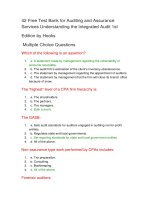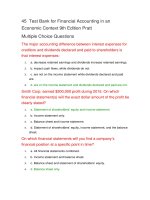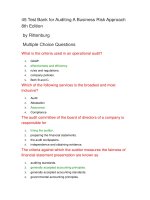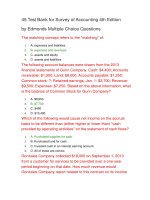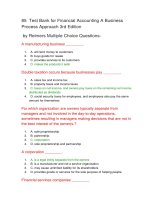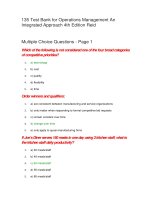45 test bank for auditing a business risk approach 8th edition
Bạn đang xem bản rút gọn của tài liệu. Xem và tải ngay bản đầy đủ của tài liệu tại đây (32.27 KB, 10 trang )
45 Test Bank for Auditing A Business Risk Approach
8th Edition
by Rittenburg
Multiple Choice Questions
What is the criteria used in an operational audit?
1.
GAAP.
2.
effectiveness and efficiency.
3.
rules and regulations.
4.
company policies.
5.
Both B and C.
Which of the following services is the broadest and most
inclusive?
1.
Audit
2.
Attestation
3.
Assurance
4.
Compliance
The audit committee of the board of directors of a company is
responsible for
1.
hiring the auditor.
2.
preparing the financial statements.
3.
the audit workpapers.
4.
independence and obtaining evidence.
The criteria against which the auditor measures the fairness of
financial statement presentation are known as
1.
auditing standards.
2.
generally accepted accounting principles.
3.
generally accepted accounting standards.
4.
governmental accounting principles.
Users can reasonably expect audited financial statements to be
1.
complete and contain all important financial disclosures, be free from
material misstatements and be presented fairly according to GAAS.
2.
complete and contain all important financial disclosures, be free from
material misstatements and be presented fairly according to GAAP.
3.
complete, be accurate and be presented fairly according to GAAP.
4.
complete and contain all important financial disclosures, be free from all
misstatements and be presented fairly according to the substance of GAAS.
The Certified Internal Auditor program is administered by the
1.
AICPA.
2.
IIA.
3.
state's board of accountancy.
4.
state's society of CPAs.
Assurance services may include which of the following?
1.
attesting to financial statements
2.
examination of the economy and efficiency of governmental operations
3.
evaluation of a division's performance for management
4.
tax preparation services
5.
A, B, and C only
Which type of auditor would typically perform an operational
audit?
1.
external auditor.
2.
internal auditor.
3.
governmental auditor.
4.
Both B and C.
5.
All of the above.
Results of the financial statement audit are communicated to
users through a(n)
1.
financial statement.
2.
written management assertion.
3.
audit report.
4.
none of the above.
A service that always requires that a report is provided to a third
party is
1.
assurance
2.
attestation
3.
audit
4.
Both B and C.
Which one of the following statements is not true about internal
auditing?
1.
Internal auditing is an objective evaluation function.
2.
Internal auditing is established within an organization.
3.
Internal auditing's purpose is to provide assurance regarding the company's
compliance with stated policies and procedures.
4.
Internal auditing is established as an independent service to regulatory
bodies and creditors.
Which type of auditor may perform a financial statement audit?
1.
external auditor.
2.
internal auditor.
3.
governmental auditor.
4.
Both A and C.
5.
All of the above.
Which one of the following is not a key attribute needed to
perform assurance?
1.
subject matter knowledge
2.
independence
3.
established criteria or standards
4.
accounting skills
The need for assurance services arises for all of the following
reasons EXCEPT:
1.
potential bias in providing information.
2.
Closeness between a user and the organization.
3.
complexity of the processing systems.
4.
remoteness between a user and the organization.
The objective of an operational audit is to
1.
evaluate whether laws have been broken by management.
2.
evaluate fairness of presentation of financial statements.
3.
evaluate compliances with company rules and regulations.
4.
evaluate the effectiveness and efficiency with which resources are
employed.
The AICPA remains a valuable organization because of its
continuing involvement in
1.
the audit standard setting process.
2.
regulation and enforcement of the audit profession.
3.
education and administration of the CPA exam.
4.
promulgation of accounting standards.
Which one of the following is not a critical component of
assurance services?
1.
a process on which service is provided
2.
an assurance service provider
3.
a user who derives value
4.
a CPA
Which one of the following is not part of the attest process?
1.
gathering evidence about assertions
2.
proving the accuracy of the books and records
3.
evaluating evidence against objective criteria
4.
communicating the conclusions reached
Auditing is a systematic process that includes all of the following
except:
1.
communicating results to users
2.
procuring and evaluating evidence
3.
providing important managerial decisions for a client
4.
comparing evidence regarding assertions to certain established criteria
As it relates to an audit, materiality is
1.
not taken into consideration.
2.
related only to the sufficiency of procedures performed.
3.
based upon audit fees.
4.
determined based upon the importance to a user of the financial
statements.
Internal auditors may perform all of the following types of audits
except
1.
operational audits.
2.
compliance audits.
3.
computer system audits.
4.
all of the above may be performed by internal auditors.
An audit which has as its purpose the evaluation of the economy
and efficiency with which resources are employed is known as
a(n)
1.
financial audit.
2.
compliance audit.
3.
operational audit.
4.
governmental audit.
Third-party users of the audit report expect the auditor to do all of
the following except:
1.
to evaluate measurements and disclosures made by management
2.
to provide a biased evaluation of the financial statements
3.
to determine whether financial statements are presented in accordance with
GAAP
4.
to gather sufficient evidence to support their opinion
An “integrated audit” includes an audit of
1.
the company’s internal controls.
2.
the company’s financial statements.
3.
the company’s compliance with its rules and policies.
4.
Both A and B.
Independent professional services that are provided on financial
or other information that improve the quality of decision making
are known as
1.
internal auditing.
2.
financial auditing.
3.
assurance services.
4.
attestation services.
Users of the audit report can reasonably expect the audited
financial statements to be.
1.
include complete information and contain all financial disclosures.
2.
presented fairly according to the substance of GAAP.
3.
free from all errors.
4.
all of the above.
5.
none of the above.
The primary governing board that performs quality reviews on
registered CPA firms that audit public companies is the
1.
PCAOB
2.
GAO
3.
AICPA
4.
FASB
Which one of the following is not a provider of assurance
services?
1.
CPAs
2.
internal auditors
3.
governmental auditors
4.
AICPA
The internal audit profession has emerged and has become
active for all of the following reasons except:
1.
management's need for an objective appraisal of organizational or
departmental performance
2.
increased internal and external emphasis on effective procedures to detect
or prevent fraud
3.
compliance with Section 404 of the Sarbanes-Oxley Act of 2002
4.
management’s need to delegate the responsibility of the financial
statements
Which of the following is not a component of assurance
services?
1.
information or a process on which the assurance services is provided.
2.
report to a third party.
3.
a user or a group of users who derive value from the service provided.
4.
a service provider.
Auditing is important in a free market society because
1.
the public requires CPAs functioning as divisions of regulatory bodies.
2.
auditors detect all errors and fraud made by company employees.
3.
it provides reliable information based upon which to judge economic
performance.
4.
the auditor is an amiable insurance policy for investors.
5.
all of the above are true.
Congress authorized which of the following organizations to
establish generally accepted accounting principles for public
companies?
1.
SEC
2.
APB
3.
AICPA
4.
FASB
Which one of the following is an example of management
expectations for independent auditors?
1.
An expert providing a written communication as the product of the
engagement.
2.
Individuals who perform day-to-day accounting functions on behalf of the
company.
3.
An active participant in management decision making.
4.
An internal source of expertise on financial and other matters.
Which one of the following is not a management expectation for
independent auditors?
1.
an outside source of expertise on accounting matters
2.
individuals who perform tests and draw conclusions on assertions
3.
a participant in management decision making
4.
a provider of a written communication
The organization that issued the Internal Control, Integrated
Framework which serves as the primary criterion for evaluating
the quality of a company’s internal control system is
1.
PCAOB
2.
COSO
3.
AICPA
4.
GAO
What is the criteria used in a compliance audit?
1.
GAAP.
2.
effectiveness and efficiency.
3.
rules and regulations.
4.
company policies.
5.
Both C and D.
The public expects auditors to
1.
understand and enforce principles that best portray the spirit of FASB
concepts.
2.
be neutral to preparers and users of financial information.
3.
recognize that the public are the primary users of audit services.
4.
take more responsibility for the discovery of fraud.
5.
all of the above are expectations of the public.
CPA firms performing public financial statement audits must
1.
register with the American Institute of Certified Public Accountants.
2.
register with the Institute of Auditors.
3.
register with the U.S. General Accounting Office.
4.
register with the Public Company Accounting Oversight Board.
The audit agency for the U. S. Congress is the
1.
SEC.
2.
GAO.
3.
IIA.
4.
AICPA.
Which one of the following is a potential problem with
management's communication of financial information that causes
third parties to desire the independent auditor's assessment of the
financial statement presentation?
1.
complexity of transactions affecting the financial statements
2.
lack of criteria on which to base information
3.
remoteness of the user from the organization
4.
A and C
5.
A and B
CPAs are licensed by the
1.
PCAOB.
2.
AICPA.
3.
state's board of accountancy.
4.
state's society of CPAs.
The auditor of financial statements must make very difficult
interpretations regarding authoritative literature. Additionally, the
auditor must
1.
consider whether the application of a generally accepted accounting
principle best portrays the economic activity of the company.
2.
force management to make certain decisions regarding their financial
statements.
3.
disregard independence in order to find the underlying truth of the
evidence.
4.
establish new criteria by which financial statements may be compared.
An expectation of the public is that the auditor will recognize that
the primary users of audit assurance are
1.
the clients.
2.
the Public Company Accounting Oversight Board.
3.
members of management.
4.
third-party users.
Which of the following are part of the attest process?
1.
communicating the conclusions reached to a third party
2.
guaranteeing the accuracy of the books and records
3.
evaluating evidence against objective criteria
4.
A and C
5.
B and C
Management of a company is responsible for
1.
hiring the auditor.
2.
preparing the financial statements.
3.
the audit workpapers.
4.
independence and obtaining evidence.
